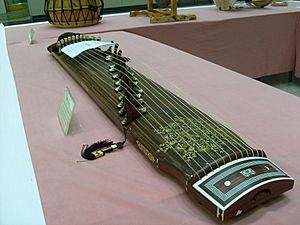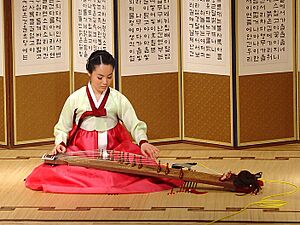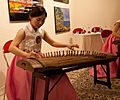Gayageum facts for kids
The gayageum (say "gah-yah-goom") is a special musical instrument from Korea. It's like a flat harp or a zither, which is a string instrument played by plucking. Most gayageums have 12 strings, but some newer ones can have 21 or more! It's one of the most famous traditional Korean instruments. The main part of the instrument is made from Paulownia wood.
Contents
History of the Gayageum
The gayageum has a long and interesting history! A very old book called Samguksagi (which means "History of the Three Kingdoms") tells us about it. It says the first gayageum was made for King Gasil in the 6th century.
King Gasil got the idea after seeing a Chinese musical instrument. He then asked a talented musician named Wu Ruk to create music for this new instrument. The instrument was first called gayago. Wu Ruk later made it even better.
How a Gayageum is Built
There are two main kinds of gayageum:
- The beobgeum gayageum is quite large. It's about 160 centimeters (about 5 feet 3 inches) long. It's made from a single piece of Paulownia wood. The inside is hollowed out to make a resonator chamber. This type is often used for playing traditional court music.
- The sanjo gayageum is a bit smaller. It's about 142 centimeters (about 4 feet 8 inches) long. Its top part, called the soundboard, is made of Paulownia wood. But its sides and back are made from stronger woods like chestnut or walnut. This type is usually played for lively folk music.
How to Play the Gayageum
To play the gayageum, the musician usually sits cross-legged on the floor. The instrument rests on their knee, usually the right one.
One hand is used to pluck the strings. This creates the main sound. The other hand is very important too! It presses, shakes, or vibrates the strings. This adds special effects and makes the music sound even more beautiful and expressive.
Images for kids
See also
 In Spanish: Kayagum para niños
In Spanish: Kayagum para niños




